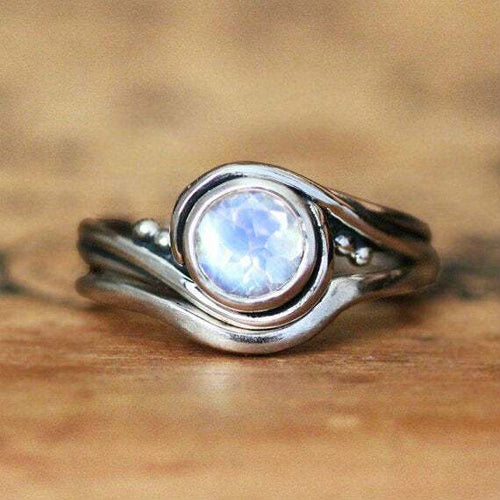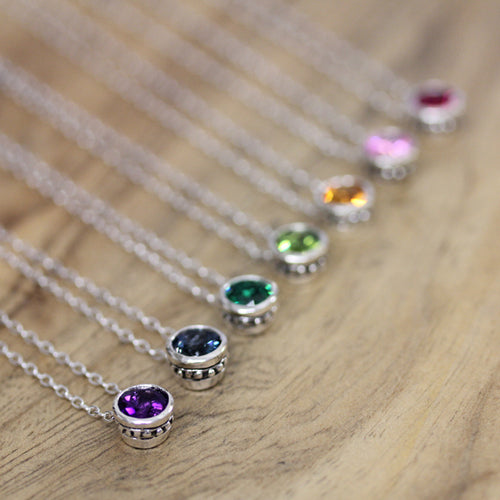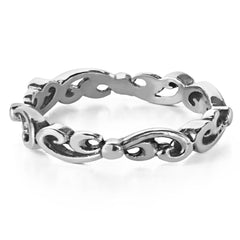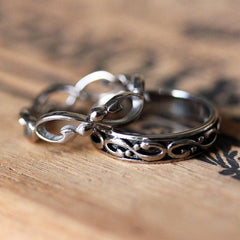One of the most often asked questions I receive is, "What are the differences in metals that you use? What is the best metal for wedding rings? And what is the best metal for me?" I've put together this guide to give you a comparison of the different metals for the wedding rings that I make in my studio so that I can help you make the very best decision for your rings. Let's get started!
RECYCLED METAL
In my studio, I work exclusively with 100% recycled metal. This means that instead of coming from a gold or silver mine, the precious metal I use has been melted down, refined and reused from alternate sources (scraps from manufacturers, computer parts, unwanted jewelry, even dental crowns) it also means that my environmental footprint is reduced. But it does not affect the properties or characteristics of the metals.
WHICH METAL IS BEST FOR YOU?
When deciding what is best for your rings, the things to consider are color, durability, and cost.
Sterling Silver
Silver is a soft but sturdy metal that has a bright, lustrous shine. Pure silver is too soft for jewelry making so I use sterling silver, which is 92.5% pure silver mixed with 7.5% other metals to make it stronger. It is a very white metal that can be highly polished as well as oxidized,or blackened, as shown above. Oxidization is a great way to create depth and volume and to show texture, it also gives my work an antique look. Silver is extremely lightweight- which can be great for those who aren't used to wearing jewelry. It is also the least expensive option for your rings. On the flip side, silver is not the most durable metal- it can scratch easily and won't last as long as your other metal options. In ancient times silver was called the lunar metal — cool and luminous, like the moon’s reflection on water.
White Gold
In some of my jewelry designs I use recycled 14k palladium white gold rather than traditional 14k white gold because when it's alloyed with palladium, white gold does not require plating (a thin coating of another metal to make it look whiter that wears off quickly). It also does not include nickel, which is what a ton of people are allergic to. 14k white gold is a heavier, harder and stronger metal than silver with a darker color. Palladium is a member of the platinum family, but it is alloyed (combined) with 14k gold for a lovely lustrous color and a hypoallergenic metal. Palladium white gold cannot be oxidized like silver, but it is an heirloom quality and extremely long lasting metal that won't tarnish. I used black enamel in the recesses in the men's ring above to get that antique look. White gold's natural luxurious qualities, durability, weight and rarity make it more expensive than silver. This metal has a beautiful grey/white quality to it that is silky smooth.
Oxidation in Sterling Silver vs. White Gold


In the photos above, you can see the sterling silver metal is whiter and the oxidation gives the ring a higher contrast. The ring made from 14k palladium white gold is darker and the contrast isn't as obvious as the sterling silver ring.
Pretty cool stuff.
14k Yellow Gold
Yellow gold is a wonderful aesthetic choice in metals for anyone who has a warmer skin tone, or just wants a little brighter color. I use recycled 14k yellow gold in my studio. The k, or karat, refers to how pure the gold is (the purest being 24k which is too soft to work with). Pure 24k gold is a very soft metal, so it is alloyed with other metals such as copper and silver to give it strength and durability. That being said, its malleability make it a dream to work with in jewelry. It will not tarnish and is long lasting but it is softer than white gold but harder than sterling silver. The metal is not too rare, so pricing will be in the mid range between silver and palladium white gold. Yellow gold is a classic choice that has a long standing history, going back to Egyptian times.
14k Rose Gold
Rose gold is 14k gold that is alloyed with copper to give it that beautiful rosy-pink tone. While this is still mostly gold, the majority of the alloy it is mixed with is copper, so rose gold is not a good choice for people with a copper allergy. Rose gold is a gorgeous choice for the non-traditional, and looks amazing with all kinds of gemstones. The color is extremely warm and rich. As with other 14k gold, rose gold will not tarnish, rust, or corrode, but it is a softer metal and is susceptible to scratching over time similar to yellow gold. It is very long lasting and durable and an heirloom quality metal. Rose gold is very popular, and is very timeless and it's rich tone is the perfect accent to wear everyday.
Platinum
Platinum is considered the most precious of all the metals. It's the most rare, most durable, the heaviest and most valuable. This is the most luxurious choice and the longest lasting. Platinum is a beautiful, silvery-white metal that has a lovely glow to it. It is hypo-allergenic, will not tarnish or rust and is an heirloom quality metal. Rings made from platinum will be handed down through generations.
Metal comparison chart
This chart compares the fine metals that I use in my engagement rings and wedding bands:

I hope this overview helps you to choose the best metal for you- if you have any other questions, feel free to contact me here.










